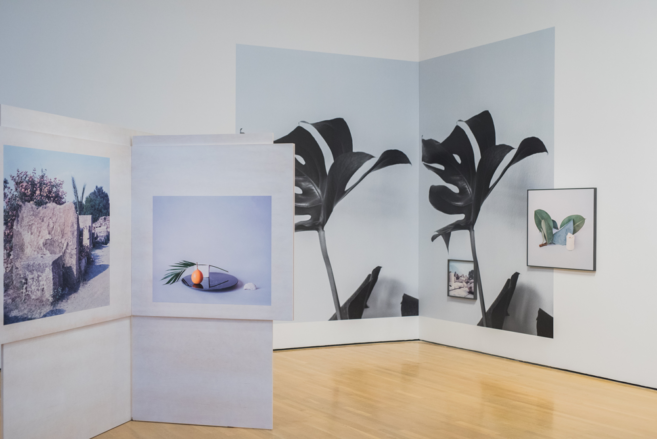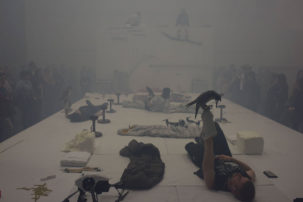Anne Imhof, Kerry James Marshall, Moyra Davey and others participated in its internationally positioned 2016 edition. But ultimately, the Biennale de Montréal ended up in an apparently insurmountable pile of debt.
According to documents obtained by Canadian Art, the two-decade-old biennale has filed for bankruptcy. The documents, dated February 15, 2018, and addressed to Canada’s Superior Court, as well as signed by Biennale de Montréal board chair Cédric Bisson, indicate that the organization owes more than $200,000 in outstanding debts to creditors.
The 33 creditors listed range widely, including Artforum magazine, New York “global cultural communications company” Sutton PR, and the biennale’s own accounting firm, Dagenais, Lapierre, Simard et Associes. (Full disclosure: Canadian Art Foundation, the charitable foundation that publishes Canadian Art, is also listed among the creditors in the document.)
Hardest hit among creditors is the Montreal-based art transportation company PACART, which is owed more than $70,000 by the bankrupt biennale—more than any other creditor.
“I am very frustrated,” says Pierre Béchard, president and founder of PACART, in a phone interview. Béchard says PACART worked with the Biennale de Montréal since both organizations were founded in 1998—and he never had a problem with getting paid until the 2016 edition.
“We handled all transportation of artworks—local, national and international,” Béchard explains. PACART made sure most of the works in the biennale arrived at their desired locations for critics and publics to enjoy. And yet PACART hasn’t yet seen a cent, Béchard says, of the money it is owed by the biennale for its work on the 2016 edition.
Other local arts players are listed in the document as being owed money, too—from the ticket sales hub La Vitrine on Ste-Catherine Est to sprawling Montreal culture complex Place des Arts, whose Cinqième Salle was rented out by the biennale for artist talks.
After PACART, the most significant debts listed are owed the hotel Renaissance Montreal Centre-Ville, New York’s Sutton PR, and two Visa card accounts at Desjardins bank.
Local Artist Questions Biennale Board Efforts
Notable though, too, perhaps, is who is not listed among the creditors—namely, individual artists and a variety of individual art-related workers who, as Canadian Art reported in July 2017, had still not been paid some six months after the biennale had wrapped up its 2016 edition. Some of these contractors have privately confirmed to Canadian Art that they had finally been paid later in 2017 following many repeated follow-ups with biennale board and administration.
Yet at least one Montreal artist and culture worker—Emmanuel Galland—believes that the board’s failure to keep the biennale going has a wider negative impact on artists in the city. He argues that the bankruptcy “tarnish[es] the reputation of our artistic community, here and beyond the borders of Quebec.”
In a recent Facebook post, Galland also argued that a debt in the range of $200,000 was manageable enough to have been overcome, especially for an biennale that had $1.25 million in income in 2017.
“Shame on the management and board of directors, who give up… rather than looking for possible solutions,” Galland wrote on Facebook. He added via email that the biennale’s debts could have been reduced if the board members “took outside advice” or “would have been able to communicate to the community, the media and arts councils.”
When contacted for comment, biennale board chair Cédric Bisson, who is partner at a venture capital firm, did not return calls by press time. (Even so, the biennale’s website was still accepting donations through Canada Helps, noting that its charitable organization status makes all donations of $10 or more tax-deductible.)
In the absence of direct comment from its directors, this statement in a February 27 report, prepared by Deloitte bankruptcy trustees for biennale creditors and posted to the French section of the Deloitte website, offers one explanation for the decision to fold the 20-year-old event: “Since the 2016 fiscal year, the [biennale] has not been not able to create the balanced budget required to produce its events. According to its leadership, the realm of philanthropy is very competitive and projects needing support are numerous; the financing for the production of these fixed-cost events therefore represents a significant challenge. “
The Deloitte report statement continues: “In the months leading up to its bankruptcy, [the biennale] was thus unable to generate the income necessary to sustain its events via fundraising campaigns and individual outreach…. Not being fit to meet its obligations, the biennale, on February 9, surrendered its assets and Deloitte was named its trustee in bankruptcy.”
What of a Biennial for Montreal, Then?
So where does this leave the notion of a future biennial or triennial in Montreal? It’s uncertain. Up until a few years ago, the Musée d’art contemporain de Montreal was holding what it called the Quebec Triennial. But it gave that up in 2013, when it began to partner with the Biennale de Montréal more collaboratively.
At that time, four years ago, when the biennale was shifting away from the administration of the Centre International d’Art Contemporain and towards the formation of its own non-profit charity that would work in collaboration with the MAC, Musée d’art contemporain board chair Alexandre Taillefer told La Presse that within 10 years, he wanted Biennale de Montreal to be one of the “20 or 25 biennales that you absolutely have to see worldwide.”
When asked for comment about whether the MAC would revive its old triennial, or take up the biennial within the mandate of the museum, Roxane Dumas-Noel, public relations manager for the MAC, offered some insight.
“In the short term, the MAC won’t revive a Biennale or Triennale, given the museum’s major renovation project that will start in 2019,” Dumas-Noel wrote via email. “According to the schedule, the museum will reopen in 2021. In the meantime, the museum will pursue its activities in a temporary location.”
But it sounds like the museum (whose board is still chaired by Alexandre Taillefer) would like something to happen on Montreal’s major art-event front.
“We believe that an international artistic event in contemporary art, bringing together Québec, Canadian and international artists, is essential for Montréal, Québec and Canada,” Dumas-Noel notes. “The MAC is evaluating different scenarios for the reopening of the museum and for its future program.”
When asked whether the MAC itself (which is not listed in the documents as being among the bankruptcy’s 33 creditors) was impacted by the biennial’s failure, Dumas-Noel downplayed its effects while also admitting some financial consequences.
“Responsibility for the general and artistic direction of the Biennale, as well as its execution, lay with the Biennale de Montréal,” Dumas-Noel wrote. “Consequently, the [bankruptcy’s] impact on the museum’s reputation is minimal, especially since the exhibitions that followed the Biennale were very popular with the public.”
Her statement concluded thus: “However, the MAC had invested financially in producing the Biennale and had to make a financial effort to absorb the deficit.”
The Life & Death of the Biennale de Montreal
1998 Biennale is launched by the not-for-profit CIAC, the Centre international d’art contemporain de Montreal. Since CIAC does not have its own space, the first seven editions of the biennale are housed in temporary venues.
2011 The biennale, according to La Presse, has poor attendance, putting pressure on the organization to find new models of producing the event in order to retain provincial funding.
April 2013 The Biennale de Montréal becomes an independent non-profit organization and forms a “strategic partnership” with the Musée d’art contemporain de Montréal. The museum stops producing its Quebec Triennial event and collaborates curatorially and space-wise with the restructured organization. MAC board chair Alexandre Taillefer says he is confident it will become one of the top 20 biennales worldwide within 10 years.
September 2016 Biennale de Montréal launches with works by Anne Imhof, who goes on to win the Golden Lion at the Venice Biennale the following spring, and Hassan Khan, who goes on to win the Silver Lion there, too.
April 2017 La Presse reports on failure of biennale to pay artists and contract workers four months after event closes. Similar reports by other outlets, including Canadian Art, follow through the summer.
July 17, 2017 The biennale issues a press release that states: “Financing remains a key concern for La Biennale de Montréal. The 2016 edition ends up with a significant budget shortfall that will be challenging for the organization. The Board of Directors is pursuing multiple avenues to solve this shortfall and solicits granting agencies to this effect. It is the Board’s strong intent to find the best solution for the unpaid expenses of BNL MTL 2016. La Biennale wishes to thank all the arts councils for their support.”
February 9, 2018 The Biennale de Montreal files for bankruptcy, according to papers from Industry Canada.
February 15, 2018 Biennale board chair Cédric Bisson signs Superior Court documents indicating that the biennale has some $230,000 of outstanding debts, once assets are accounted for. Thirty-three creditors are listed.
February 27, 2018 Deloitte issues report for an official meeting of biennale creditors. It states: “Since the 2016 fiscal year, the [biennale] has not been not able to create the balanced budget required to produce its events. According to its leadership, the realm of philanthropy is very competitive and projects needing support are numerous; the financing for the production of these fixed-cost events therefore represents a significant challenge.”

 Anne Imhof's performance Angst III took place at the Musée d'art contemporain de Montréal as part of the Biennale de Montréal. Photo: Jonas Leihener via Facebook.
Anne Imhof's performance Angst III took place at the Musée d'art contemporain de Montréal as part of the Biennale de Montréal. Photo: Jonas Leihener via Facebook.







